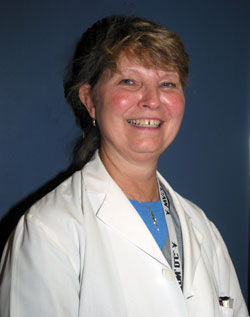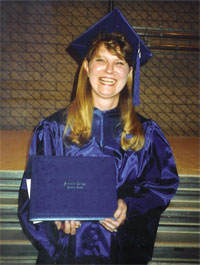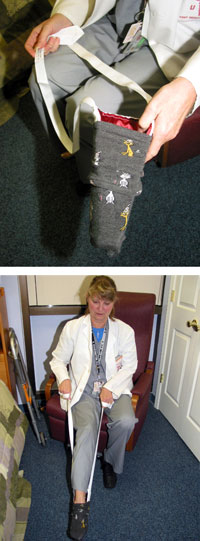 |
 |

|
|
Nancy M. Bernier, Occupational Therapy Assistant (contractor), Occupational Therapy Department, Walter Reed Army Medical Center, Washington, DC
|
1. I chose this career because...
2. My typical workday involves...
3. What I like best/least about my work...
4. My career goals are...
5. When I'm not working, I like to...
|
|
1. I chose this career because...
|
Back to Top

|

|
|
Nancy Bernier at her graduation from the Amarillo College occupational therapy assistant program.
|
I chose to become an occupational therapy (OT) assistant because 12 years ago I had breast cancer and saw first-hand the benefit that the OT assistant gave to the patient. I was an accounts payable supervisor at the time. Before that, I was a secretary, then worked in real estate and then in accounting. After completing my chemotherapy and radiation treatments, and during recovery, I began to consider a new career.
Being impressed with the possibilities in the medical field, I started researching education programs. I attended an educational fair at a local college and narrowed my career choices to physical therapy or occupational therapy. After observing an occupational therapist at work, and talking with instructors, I decided that OT would suit me best. It covered a wide variety of physical aspects as applied to real-life situations. I applied to the program at the local community college. It was a very competitive program and required that the applicant successfully complete the following college courses: psychology, medical terminology, introduction to occupational therapy and anatomy and physiology. Acceptance in the program was based on passing grades, an interview with the instructor, and references. I was among the 25 students accepted in the program. I left my job in accounting and returned to school full-time.
Education and Certification
- Associate in Applied Science, Occupational Therapist Assistant, Amarillo College, Amarillo Texas
- National Certification, American Occupational Therapy Association (AOTA) http://www.aota.org/
- State Certification, Texas, (Requires 30 continuing education units every 2 years.)
|
|
2. My typical workday involves...
|
Back to Top

|

|
|
Nancy Bernier demonstrates the use of a sock aid - a device that helps patients put on their socks.
|
My typical workday starts with the same goal – to return the patient to the functional level that he/she had before their injury occurred. I work with patients who have all types of injury, and even stroke victims. Many of them have limited mobility in some way. My strategy is to help them strengthen the upper body, increase their range of motion, and enable them to participate effectively in the activities of daily living. The patient must understand that he/she will not do things in the same way as before the injury. We work on alternative ways to accomplish daily tasks such as bathing, brushing teeth, getting dressed, and cooking. The goal is to have the patient become independent. The majority of patients are very motivated because they want to be independent. I introduce them to equipment “helpers” that help them to accomplish daily tasks independently like the:
- Long handle bath sponge – a device that helps patients bath themselves
- Long handle shoe horn – a device that helps patients put on their shoes
- Sock Aid – a device that helps patients to put on their socks
- Reacher – a device that helps patients reach things and dress themselves
- Leg Lifter – a device that helps patients with leg mobility, for example, used as an aide to get in and out of bed.
My typical day starts with inpatient rehabilitation. I review service requests from the doctors and new patients are added to my responsibilities from time to time. I usually work with the same patient over a long period of time. For example, I typically spend an hour a day for 5-6 months with my soldier patients, and 7 days with a heart bypass patient. Each session will last about 30 to 60 minutes and involves patient education. Patients are then asked to practice their new skills at home or in their hospital room.
My activities are different from the occupational therapist since I am not involved in an initial evaluation of the patient, or in setting goals for the patient. I also do not have the extensive paperwork to complete like the OT.
Additional Responsibilities:
- Family training – I help train family members to assist the patient when they return home.
- Clinical instruction - I also provide clinical instruction to new students. In the military, the student has 6 months of academic training, then 4 months of on-the-job training.
|
|
|
 |